Previous FI Curriculum – Ch. 1
Subject Pronouns
A pronoun replaces a noun in order to avoid repetition. Subject pronouns are subjects of verbs. In French, a subject pronoun is immediately or almost immediately followed by its verb. The use of subject pronouns is mandatory in French; always use a subject pronoun to construct sentences in the absence of a noun subject. Here are the French subject pronouns:
| person | singular | plural |
| 1st person | je, I | nous, we |
| 2nd person | tu, you | vous, you/y’all |
| 3rd person | il, he/it elle, she/it on, one/we (colloquial) iel, they (gender-neutral) |
ils, they (masc.) elles, they (fem.) iels, they (gender-neutral) |
Subject pronouns are labelled by the term ‘person’, referring to the subject’s role in the conversation. 1st person refers to the person(s) speaking (I, we); 2nd person to the person(s) spoken to (you); and 3rd person to the person(s) or thing(s) spoken about (he, she, it, they).
je
Unlike the English pronoun ‘I’, je is not capitalized unless it begins a sentence.
tu
The pronoun tu is singular and, importantly, informal. Use tu to address people your own age and those you know well.
on
The pronoun on means ‘one’, or ‘they’ in a nonspecific sense: ‘comme on dit’ (as they say). On often replaces ‘nous’ in spoken French: ‘On y va?’ (Shall we go?).
vous
The pronoun vous is conjugated with a plural verb so it obviously refers to more than one person. However, it is also the customary form of address when you are talking to only one person you do not know well, such as an elder, a boss, a shopkeeper, etc. Inappropriate use of the tu form is considered a sign of disrespect.
| Tammy: Bonjour, Paw-Paw. Vous allez bien? | Tammy: Hello Paw-Paw. Are you doing well? |
| Paw-Paw: Ah, oui! Et vous, mes enfants, Tex, Tammy, vous allez bien? | Paw-Paw: Ah, yes! And you, kids, Tex, Tammy, are you doing OK? |
il/elle
Il and elle besides meaning ‘he’ and ‘she’ can both express the meaning ‘it’ depending on the gender of the noun being replaced. For example:
| Bette: La musique est bonne, n’est-ce pas? | Bette: The music is good, isn’t it? |
| Tex: Non, elle est terrible! Je déteste la musique country. | Tex: No, it’s terrible. I hate country music. |
| Bette: Oh, qu’est-ce que tu as fait, Tex? Le juke-box est cassé? | Bette: Oh, what did you do, Tex? The juke-box is broken? |
| Tex: Oui, il est cassé! | Tex: Yes, it is broken! |
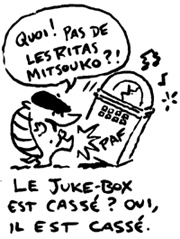
iel
A singular gender-neutral pronoun—-
ils/elles
Ils and elles are similar to il and elle since they agree with the gender of the noun they replace. Ils and elles may refer to people or things. Elles is used to mean ‘they’ if it replaces people who are all women or objects that are all feminine in gender. On the other hand, ils is used to mean ‘they’ for objects that are masuline in gender or a group of all men or any group where there is at least one male person or masculine object in the group.
| Bette et Tex sont de bons amis. | Bette and Tex are good friends. |
| Normalement ils s’entendent bien, mais pas aujourd’hui! | Normally, they get along well, but not today! |
Listen to the dialogue:
| Fiona: Bonjour Tex, tu vas bien? | Fiona: Hi Tex, are you doing well? |
| Tex: Pas du tout, je vais très mal. Je veux écouter de la musique française. Et puis Bette et moi, on s’est disputé. | Tex: Not at all. I’m doing poorly. I want to listen to some French music. And then Bette and I had a fight. |
| Fiona: Ah bon? Elle est toujours là? | Fiona: Oh really? Is she still here? |
| Tex: Non. Elle est partie avec Tammy. Elles sont allées au Broken Spoke. | Tex: Non, she left with Tammy. They went to the Broken Spoke. |
| Fiona: Tiens, nous y allons, toi et moi? | Fiona: Hey, why don’t you and I go there? |
| Tex: Tu ne m’as pas entendu? Je n’aime pas la musique country!!! Beurk! Qu’est-ce qu’on aime la musique country au Texas! | Tex: Didn’t you hear me? I don’t like country music!!! Argh! People really like country music in Texas! |
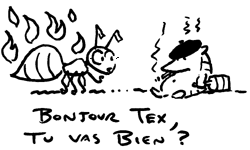
iels
A plural gender-neutral pronoun—-
être – to be
The verb être is an irregular verb in the present tense. Listen carefully to its forms in the present. Do you hear the liaison or linking in the pronunciation of the –s in the vous form? It is pronounced as a /z/ to link with the vowel ê in êtes.
| être ‘to be’ | |
| je suis ‘I am’ | nous sommes ‘we are’ |
| tu es ‘you are’ | vous êtes ‘you are’ |
| il/elle/on est ‘he/she/one is’ | ils/elles sont ‘they are’ |
| past participle: été | |
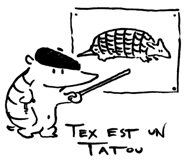
| Edouard: Mais non, Joe-Bob, tu n’es pas un tatou! | Edouard: But no, Joe-Bob, you are not an armadillo! |
| Tex est un tatou. Tex et Tammy sont des tatous. | Tex is an armadillo. Tex and Tammy are armadillos. |
| Toi et moi, nous ne sommes pas des tatous. | You and I, we are not armadillos. |
| Toi, tu es un écureuil et moi, je suis un escargot, un escargot français. | You are a squirrel and I am a snail, a French snail. |
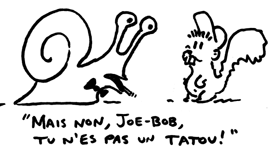
C’est (plural Ce sont) is a common expression used to describe and introduce people or things. See c’est vs. il/elle est for more information. Etre is also used as an auxiliary in compound tenses (passé composé with être, passé composé of pronominal verbs, plus-que-parfait, etc.)
Gender: masculine, feminine
In French, a noun is always feminine or masculine. It is introduced by a determiner, which usually indicates the gender of the noun.
people
When a noun refers to a person, the gender is determined by the person’s sex (although some exceptions do exist).
In general, the feminine form of the noun is formed by adding an -e to the masculine noun. Note that the addition of the -e changes the pronunciation in some words:
| Joe-Bob est étudiant, Tammy est aussi étudiante. | Joe-Bob is a student, Tammy is a student |
| Tex est ami avec Joe-Bob, Tammy est aussi amie avec Joe-Bob. | Tex is Joe-Bob’s friend, Tammy is also Joe-Bob’s friend. |
There are cases when the feminine form of the noun changes more drastically.
| Edouard: Je suis serveur. Tammy: Je ne suis pas serveuse. |
Edouard: I’m a waiter. Tammy: I’m not a waiter. |
| Trey: Je suis musicien. Tammy: Je ne suis pas musicienne. |
Trey: I’m a musician. Tammy: I’m not a musician. |
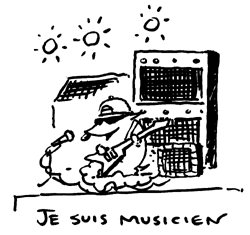
| Tex: Je suis un séducteur. Bette: Je suis une séductrice. |
Tex: I’m a womanizer. Bette: I’m a seductress. |
| Joe-Bob: Pour le travail, je ne suis pas champion. Fiona: C’est moi qui suis championne. |
Joe-Bob: I’m not a champion at working. Fiona: I’m the one who is a champion. |
| Tex: Je suis le copain de Tammy. Tammy: Je suis la copine de Tex. |
Tex: I’m Tammy’s pal. Tammy: I’m Tex’s pal. |
In general, when the masculine noun ends in -e, the feminine noun remains unchanged. Only the determiner or the context indicates if it is a feminine or masculine noun.
| Tex et Rita sont frère et soeur, mais ils ont des métiers tout à fait différents. | Tex and Rita are brother and sister, but they have completely different jobs. |
| Tex est poète. Rita est secrétaire. | Tex is a poet. Rita is a secretary. |
| Tex n’est sûrement pas secrétaire et Rita n’est pas poète non plus. | Tex is certainly not a secretary and Rita is not a poet either. |
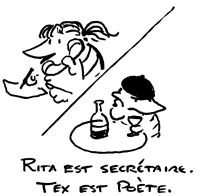
animals
The gender of animals is often arbitrary. Some animals are always masculine (un escargot, a snail), others are feminine (la fourmi, ant). However, for some animals there are irregular masculine and feminine forms.
| le chat / la chatte | cat |
| le chien / la chienne | dog |
| le coq / la poule | chicken (rooster / hen) |
| le boeuf, le taureau / la vache | ox / bull / cow |
objects and ideas
The gender of nouns referring to things and abstractions is arbitrary. However, it can often be inferred from the ending of the word. Typically, words ending in -age, -ment, -eau, -phone, -scope, -isme are masculine and those ending in -tion, -sion, -té, -ette, –ance, -ence, -ie, -ure, -ode/-ade/-ude are feminine.
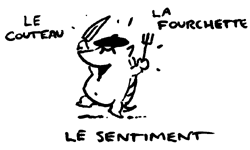
| masculine endings | feminine endings |
| le fromage (cheese) | la salade (salad, lettuce) |
| le monument (monument) | la fourchette (fork) |
| le sentiment (feeling) | la télévision (television) |
| le couteau (knife) | la culture (culture) |
| le téléphone (telephone) | la situation (situation) |
| le microscope (microscope) | la société (society) |
| le romantisme (romanticism) | la différence (difference) |
| la philosophie (philosophy) |
Listen to the dialogue. Feminine nouns are in blue, masculine in black.
| Tammy présente Tex pour la première fois à Bette et Fiona. | Tammy introduces Tex for the first time to Bette and Fiona. |
| Tammy: Tex est un ami de Lyon. C’est un tuteur maintenant! Tex, la minette c’est mon amie Bette, et la fourmi c’est ma copine Fiona. Bette et Fiona sont étudiantes. | Tammy: Tex is a friend from Lyon. He is a tutor now! Tex, the kitty is my friend Bette and the ant is my pal Fiona. Bette and Fiona are students. |
| Bette: Enchantée, Tex! J’adore la culture française. | Bette: Nice to meet you, Tex. I adore French culture. |
| Tex: Ah, donc tu, . . . tu aimes l’existentialisme? | Tex: Ah, so you, . . . you like existentialism? |
| Bette: Euh, oui, bien sûr, Tex. | Bette: Uh, yes, of course, Tex. |
Introduction to nouns
A noun is essentially a label for places, things, events, ideas, concepts and so on. Like English, nouns in French may be categorized as common or proper, count or mass, singular or plural. However, unlike English, French nouns are also categorized as either masculine or feminine.
common vs. proper
Common nouns in English and French are the generic term for something. Common nouns are never spelled with a capital letter unless they begin a sentence.
| un tatou | an armadillo |
Proper nouns are specific names and thus begin with capital letters.
| Tex et Tammy | Tex and Tammy |
count vs. mass
Another way of classifying nouns is according to whether they can be counted or not. Count nouns identify individual entities that can be counted, like armadillos.
| un tatou, deux tatous | one armadillo, two armadillos |
In contrast, a mass noun refers to an entity as an uncountable unit. In the following example, the bread that Tex is eating is conceived of as a mass, that is, an undefined quantity.
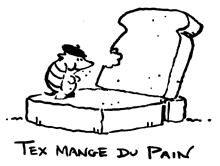
| Tex mange du pain. | Tex is eating bread. |
The difference between count and mass nouns is usually clearcut. However, something that is typically countable such as an animal (one armadillo, two armadillos, three armadillos) can nevertheless be conceived of in terms of a mass, as in the following tasteless example.
| Berk! Il y a du tatou écrasé partout sur les autoroutes du Texas. | Yuck! There’s squashed armadillo all over the Texas highways. |
singular vs. plural
All nouns in French and English are marked for number, that is, for singular (one) or plural (more than one). French, like English, usually indicates plurality by adding an -s to the end of the base form, the singular noun. Count nouns have both singular and plural forms:
| le tatou, les tatous | the armadillo, the armadillos |
Mass nouns typically have only a singular form. Try saying the plural forms of the following English mass nouns: sewage, mucus, plasma.
It sounds strange doesn’t it? This shows that it is difficult to pluralize a mass noun.
masculine vs. feminine
In English, grammatical gender is based on biology and is only relevant for pronouns (he, she, it) and possessive determiners (his, her, its). Gender in French, on the other hand, affects all nouns, pronouns, adjectives and articles. A noun’s gender is indicated by the article that precedes it. Masculine nouns are preceded by le and feminine nouns by la. The use of articles in French is more widespread than in English.
| le garçon | the boy |
| la fille | the girl |
Unlike English, the grammatical concept of gender in French has little to do with biological sex. Therefore, inanimate objects such as tables and desks are categorized as either masculine or feminine (there is no neuter gender in French grammar).
| la table (feminine) | the table |
| le bureau (masculine) | the desk |
Remember that gender in French, for the most part, is not about sex, but is simply an arbitrary category. The terms ‘masculine’ and ‘feminine’ really mean nothing more than ‘noun class A’ and ‘noun class B’. Because grammatical gender is fairly arbitrary, it is essential to memorize a noun’s gender along with its spelling and pronunciation.
Determiners: Definite articles

forms
In French, few nouns can stand alone. Most need to be introduced or ‘determined’ by an article. As in English, an article is characterized as either definite (‘the’) or indefinite (‘a’, ‘an’). In addition, French articles are also masculine or feminine, singular or plural, according to the gender and number of the noun they determine. Here are the definite articles in French:
| masculine singular: le (l’) | |
| Tex le tatou Joe-Bob l’écureuil |
Tex the armadillo Joe-Bob the squirrel |
| feminine singular: la (l’) | |
| Bette la chatte l’Université du Texas |
Bette the cat (female) The University of Texas |
| masculine and feminine plural: les | |
| les tatous les écureuils les chats les universités |
the armadillos the squirrels the cats the universities |
élision and liaison
In the examples above, note that le and la both become l’ when they precede a noun beginning with a vowel or a silent h: l’escargot, l’université. This is called elision.
Unlike le and la, les does not have a contracted, reduced form. When les is followed by a word starting with a vowel, the normally silent final s of les is pronounced, making a /z/ sound. This additional sound linking two words is called liaison. Listen to the following examples:
| Compulsory liaison with a vowel or silent h | No liaison with a consonant |
| les insectes les animaux les hommes |
les tatous les fourmis |
Note that elision and liaison occur with most words starting with h: l’homme, les hommes, l’hiver, les hivers. Exceptions to this rule are words beginning with an aspirate ‘h’.
to identify a specific noun
The definite article is used to identify a specific noun or to refer to a noun that has already been specified.
| Corey: Tu connais la tour de l’Université du Texas? | Corey: Do you know the UT Tower? |
| Tex: Bien sûr, c’est le symbole de l’Université! | Tex: Of course, it is the symbol of the University! |
| Corey: Et la Sixième rue? | Corey: What about Sixth street? |
| Tex: Eh bien, c’est les Champs-Elysées d’Austin! | Tex: Well, it’s the Champs-Elysees of Austin. |
to express general truths or concepts
French uses the definite article to express general truths or concepts. English, in contrast, uses no article at all. Compare the following sentences:
| Tex: L’argent ne rend pas l’homme heureux! | Tex: Money does not make man happy! |
| Tammy: Tu as raison. L‘amour et la santé sont plus importants! | Tammy: You are right. Love and health are more important! |
| Tex: Bien sûr, pour les insectes et les animaux, l’argent n’existe pas! Mais l’amour est aussi important pour nous que pour les humains. Ah oui … l’amour l’amour, toujours l‘amour! | Tex: Of course, for insects and animals, money does not exist! But love is as important for us as it is for humans. Ah, yes, love, love, love, always love! |
to express likes and dislikes
The French also use the definite article with verbs of preference, such as aimer, préférer, détester. Once again, English omits the article in such general statements. For example:
| Tex adore les croissants. | Tex loves croissants. |
| Joe-Bob préfère les doughnuts. | Joe-Bob prefers doughnuts. |
| Tammy n’aime pas le café. | Tammy does not like coffee. |
| Edouard apprécie la bonne cuisine française. | Edouard appreciates good French cuisine. |
to indicate habitual recurrence
The definite article is used in French with moments of the day, days of the week, and seasons to indicate habitual recurrence. For example:
| Le matin, Tammy va en cours. | Every morning, Tammy goes to class. |
| L‘après-midi, elle va à la bibliothèque. | Every afternoon, she goes to the library. |
| Le lundi, Tex fait son jogging. | On Mondays, Tex goes for a jog. |
| L‘été, il se baigne avec Tammy à Barton Springs. L’hiver, il skie à Purgatory. | Every summer, he bathes with Tammy at Barton Springs. Every winter, he skis in Purgatory. |
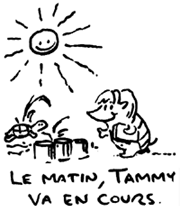
in a series
The article is usually repeated in a series, in contrast to English. For example:
| Tammy: Tex, aide-moi à mettre la table! Apporte les assiettes, les couteaux, les verres, les serviettes et le vin. | Tex, help me set the table! Bring the plates, knives, glasses, napkins, and wine. |
no article
Cities usually do not require an article in French. For example:
| Tex habite à Austin, mais il préfère Paris. |
Tex lives in Austin, but he prefers Paris. |
Continents, countries, states, regions, and oceans usually require an article (l’Afrique, la France, le Texas, la Bourgogne, l‘Atlantique etc.), but there are a few exceptions, usually islands: Haïti, Israël, Madagascar. See prepositions with place names for more information.
Months never require an article: janvier, février, mars, etc.
| Cependant Tex adore mars à Austin. | Nevertheless Tex adores March in Austin. |
Days of the week do not require an article in instances where they do not indicate habitual recurrence. For example:
| Lundi, il a rendez-vous avec Tammy. | Monday he has a date with Tammy. |
Listen to the dialogue:
| Tammy: J’aime beaucoup le français. C’est la langue de Molière et de Hugo, et surtout c’est la langue maternelle de Tex! | Tammy: I like French a lot. It is the language of Molière and of Hugo, and above all it is the mother tongue of Tex! |
| Bette: Alors comme ça Tammy, tu aimes bien les Français? | Bette: So Tammy, you really like French men? |
| Tammy: Oh oui! Surtout les Français qui portent le béret! | Tammy: I sure do! Especially French men who wear a beret! |
Determiners: indefinite articles

forms
In French, few nouns can stand alone. Most need to be introduced or ‘determined’ by an article. As in English, an article is characterized as either definite (‘the’) or indefinite (‘a’, ‘an’). In French, articles are also masculine or feminine, and singular or plural, according to the gender and number of the noun they determine. Here are the indefinite articles in French:
| masculine singular: un | |
| Tex est un tatou. Joe-Bob est un écureuil. |
Tex is an armadillo. Joe-Bob is a squirrel. |
| feminine singular: une | |
| Bette est une chatte. UT est une université |
Bette is a cat. (female) UT is a university. |
| plural: des | |
| des tatous des écureuils des chats des universités |
(some) armadillos (some) squirrels (some) cats (some) universities |
In the examples above, listen carefully to the difference in pronunciation of un and des before words beginning with a consonant (un tatou, des tatous) and before a words beginning with a vowel sound (un écureuil, des écureuils). These are examples of liaison.
uses
As the English ‘a’ ‘an’ or ‘some’, the indefinite articles un, une, des refer to nouns which are non-specific. Un or une may also indicate quantity, ‘a’ or ‘an’ in the sense of ‘one.’ Contrast the use of the indefinite and definite articles in the first two sentences below. The indefinite plural des is always expressed in French, but its English equivalent ‘some’ is often omitted.
| Joe-Bob et Corey ont une chambre dans une résidence universitaire à Austin. | Joe-Bob and Corey have a (one) room in a residence hall in Austin. |
| Ils ont la chambre numéro 1735 dans la résidence Jester. | They have the room #1735 in the Jester residence hall. |
| Joe-Bob et Corey sont des camarades de chambre. | Joe-Bob and Corey are roommates! |
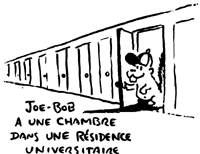
‘de’ after the negative
In a negative sentence, the indefinite articles un, une, des are replaced by de or d’:
| Tex: Joe-Bob, tu as un chien? | Tex: Joe-Bob, do you have a dog? |
| Joe-Bob: Mais non! Je n’ai pas de chien. Je suis un écureuil. | Joe-Bob: No, I don’t have a dog. I’m a squirrel. |
| Tex: Corey, tu as des amis? | Tex: Corey, do you have friends? |
| Corey: Mais non! Je n’ai pas d’amis. Je suis un cafard. | Corey: No, I don’t have any friends. I’m a cockroach. |
However, following the verb être, the indefinite articles un, une, des remain unchanged in the negative:
| Edouard: Joe-Bob, c’est un écureuil. Ce n’est pas un tatou! | Edouard: Joe-Bob is a squirrel. He is not an armadillo. |
| Tex et Tammy, ce sont des tatous. Ce ne sont pas des escargots. | Tex and Tammy are armadillos. They are not snails. |
before a plural adjective
Before a plural adjective which precedes a noun, des usually becomes de. If the adjective comes after the noun, des does not change to de.
| Edouard: Tex et Tammy sont de charmants amoureux. | Edouard: Tex and Tammy are charming lovers. |
| Bette: Ah bon? Ce ne sont pas seulement de bons amis? | Bette: Really? They are not just good friends? |
| Edouard: Tu ne trouves pas que Tex et Tammy sont des tatous parfaits l’un pour l’autre? | Edouard: Don’t you think that Tex and Tammy are armadillos who are perfect for each other? |
| Bette: Absolument pas! | Bette: Absolutely not! |
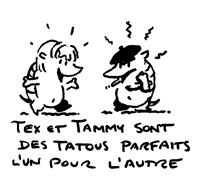
with adjectives of profession, nationality, and religion
Professions, nationalities and religions are considered adjectives in French and need no article after the verbs être and devenir.
| Edouard: Tex devient professeur; il est américain; il n’est pas catholique. | Edouard: Tex is becoming a professor. He is American. He is not Catholic. |
Listen to the dialogue:
| Bette et Tammy parlent entre femmes. | Bette and Tammy are talking woman-to-woman. |
| Bette: Je n’ai pas de véritables amis! Tout le monde pense que je suis une méchante chatte. | Bette: I have no real friends! Everybody thinks that I am a wicked cat. |
| Tammy: Mais non Bette! Toi et moi nous sommes de vieilles amies! | Tammy: That’s not true Bette! You and I are old friends!’ |
| Bette: Oui, mais toi tu as un petit ami tandis que moi je n’ai pas de petit ami! | Bette: Yes, but you have a boyfriend whereas I don’t have any boyfriend! |
| Tammy: Tu sais Bette, avoir un petit ami ce n’est pas toujours une partie de plaisir, surtout quand il s’appelle Tex! | Tammy: You know Bette, having a boyfriend is not always a fun thing, especially when he’s called Tex! |
Voilà vs. il y a
Il y a and voilà are two ways of introducing nouns. They are translated into English as ‘there is / there are’ or ‘here is / here are.’
il y a
Il y a + noun usually indicates the existence of a person or a thing in the context of a particular setting. It is commonly translated as ‘there is’ or ‘there are.’ For example:
| A Austin, il y a une grande université. | In Austin, there is a big university. |
| Dans cette université, il y a plusieurs animaux qui parlent le français! | At this university, there are several animals who speak French! |
| Parmi ces animaux, il y a des tatous, un escargot, une chatte, un écureuil, et plusieurs insectes! Attention! | Among these animals, there are armadillos, a snail, a cat, a squirrel, and several insects! Careful! |
The negation of ‘il y a’ is il n’y a pas, ‘there is / are not’. You will also find these forms: il n’y a plus, ‘there is / are not anymore’, il n’y a jamais, ‘there is / are never’.
| A Austin, il n’y a jamais de neige. | In Austin, there is never any snow. |
| Donc parmi ces animaux francophones, il n‘y a pas de pingouin! | So, among these French-speaking animals, there is no penguin! |
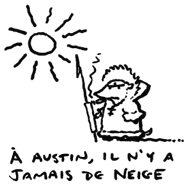
The verb avoir in the expression il y a may be conjugated in any tense or mood, for example, in the past (il y avait, ‘there was’) or in the future (il y aura, ‘there will be.’)
voilà / voici
Voilà + noun and voici + noun are commonly translated as ‘here is/are’. They are used to indicate the sudden appearance of something or someone, to introduce people or ideas. Alternating between voici and voilà is common when referring to more than one item.
| Tammy montre le campus à Tex: Voici la bibliothèque et voilà la célèbre tour! | Tammy is showing the campus to Tex: Here is the library, and there is the famous Tower. |
| Tex: Oui, oui … | Tex: Yes, yes … |
| Tammy présente Tex: Tex, voici Joe-Bob et Corey … et voilà Edouard qui arrive. | Tammy introduces Tex: Tex, here is Joe-Bob and Corey … and there comes Edouard. |
| Joe-Bob: Bonjour, Tex. | Joe-Bob: Hello, Tex. |
| Corey: Salut, Tex. | Corey: Hi, Tex. |
| Tex: Oh, la, la, de vrais Texans … | Tex: Oh, la, la, real Texans … |

